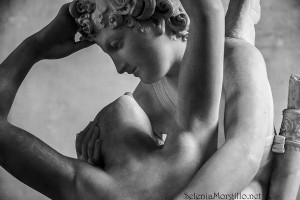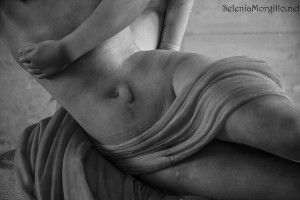Antonio Canova: Cupid and Psyche
(Italian Version below*)
Apuleius in his most important work, the Metamorphoses or the Golden Ass, tells the tale of Cupid and Psyche, a young mortal girl with a beauty that equals Venus.
The work of Antonio Canova, dated 1788, belongs to the group of mythological allegories, now exposed to the Louvre Museum.
There are two other versions, one of which with the two lovers still kept in the Louvre, and a third on display in the Hermitage Museum in St. Petersburg.
The sculptural group respects the canons of Winckelmann’s aesthetics with the two figures represented in the act preceding the kiss in a moment of great tension, but without the upheaval that would cause the kiss itself. The subjects are wrapped in a sublime atmosphere and seem suspended in a timeless space.
Canova brilliantly encompasses the ideas emanating from Neoclassicism, through the exclusive use of wisely polished marble as opposed to drama and baroque pictorialism.
In this regard, to fully understand the essence of Canova, this work could be related to a seventeenth-century masterpiece‘s: Apollo and Daphne Gian Lorenzo Bernini (exhibited at the Borghese Gallery in Rome).
Bernini freezes the fleeting moment in which Daphne is barely touched by Apollo and already has the hair that takes on the features of a laurel tree. The next instant, Daphne will be gone.
The difference between the two sculptures is not to be found in style since they are both perfectly executed as in the culture that inspired them.
All rights reserved*
——————————————————————————————————-
Apuleio nella sua opera più importante, le Metamorfosi o l’Asino d’oro, narra della favola di Amore e Psiche, giovane fanciulla mortale dalla bellezza che eguaglia Venere.
L’opera di Antonio Canova, datata al 1788, appartiene al gruppo delle allegorie mitologiche, oggi esposta al Museo del Louvre.
Ne esistono altre due versioni, di cui una con i due amanti stanti conservata sempre al Louvre, ed una terza esposta al Museo dell’Ermitage di San Pietroburgo.
Il gruppo scultoreo rispetta i canoni dell’estetica di Winckelmann con le due figure rappresentate nell’atto precedente al bacio in un momento di grande tensione, ma privo dello sconvolgimento che provocherebbe il bacio stesso. I soggetti sono avvolti da un’atmosfera sublime e sembrano sospesi in uno spazio atemporale.
Canova racchiude brillantemente le idee emanante dal Neoclassicismo, attraverso l’uso esclusivo del marmo argutamente levigato in contrapposizione alla drammaticità e al pittoricismo barocco.
In merito, per comprendere a pieno, l’essenza di Canova, si potrebbe porre in relazione quest’opera con un capolavoro del seicento: l‘ Apollo e Dafne di Gian Lorenzo Bernini (esposto alla Galleria Borghese di Roma).
Bernini congela l’attimo fuggente in cui Dafne viene appena sfiorata da Apollo ed ha già i capelli che assumono i tratti di un albero di alloro. L’istante successivo, Dafne non ci sarà più.
La differenza tra le due sculture, non è da cercarsi nello stile, essendo entrambe di perfetta esecuzione quanto nella cultura che le ha ispirate.
Dove trovarlo: QUI
Sostieni la #culturachevince, aiuta la condivisione

